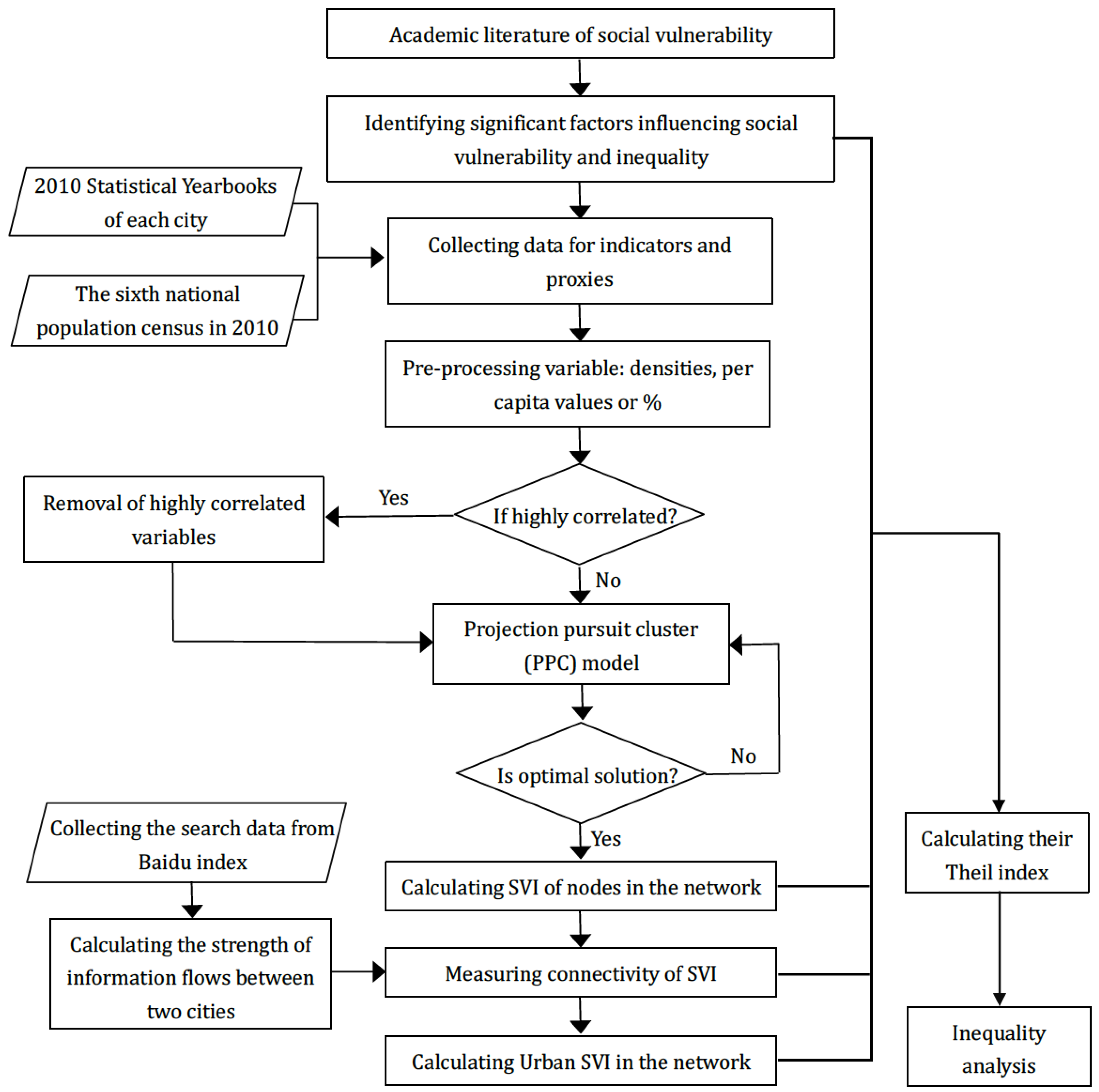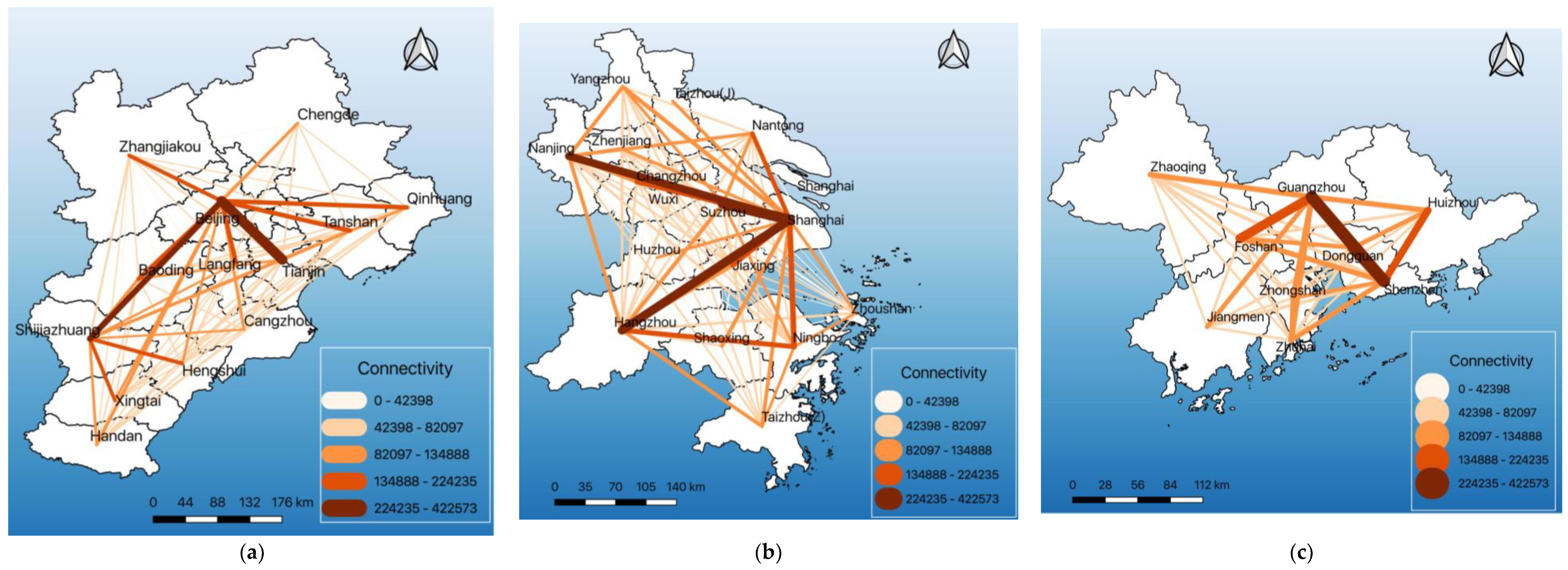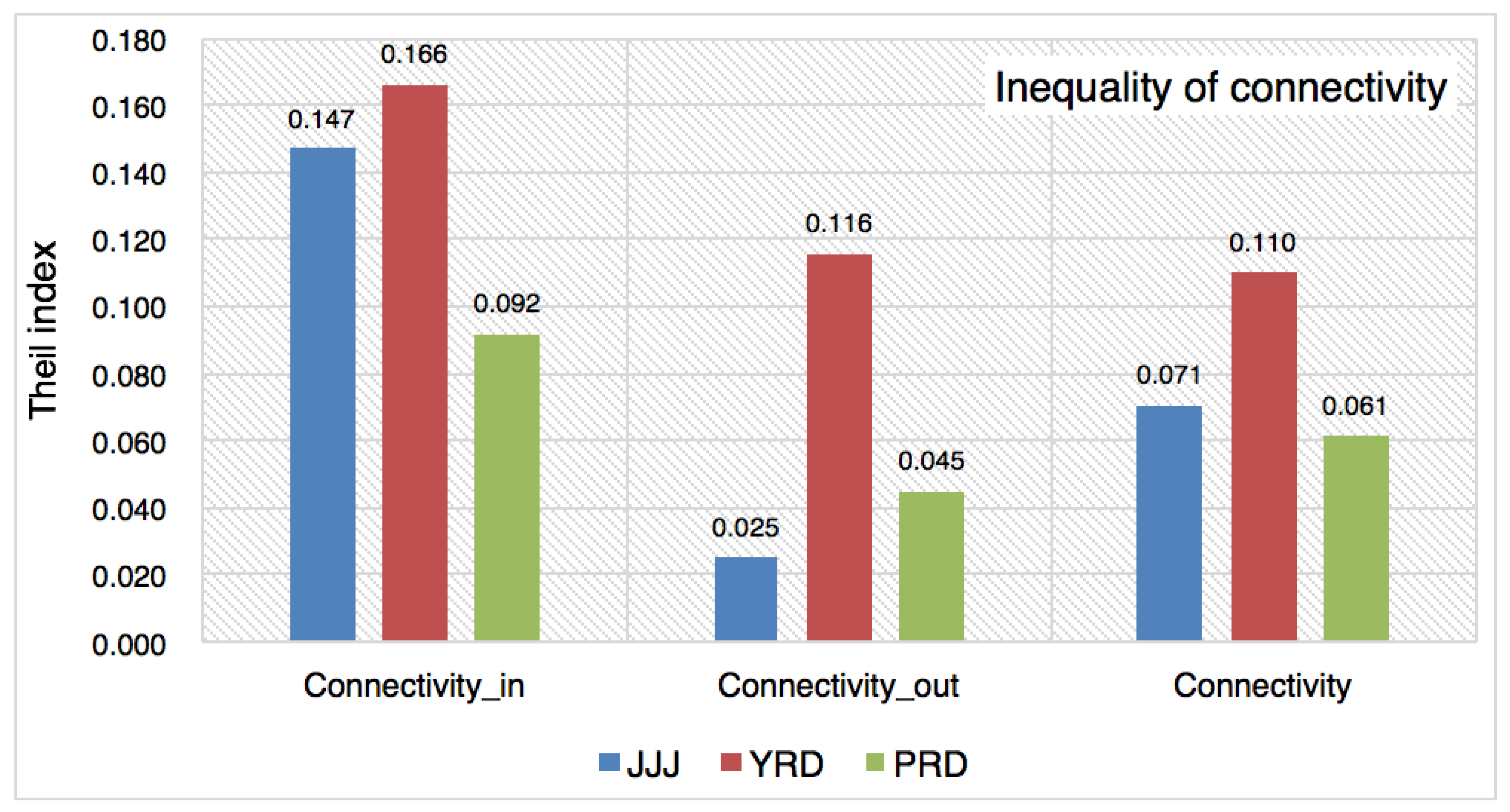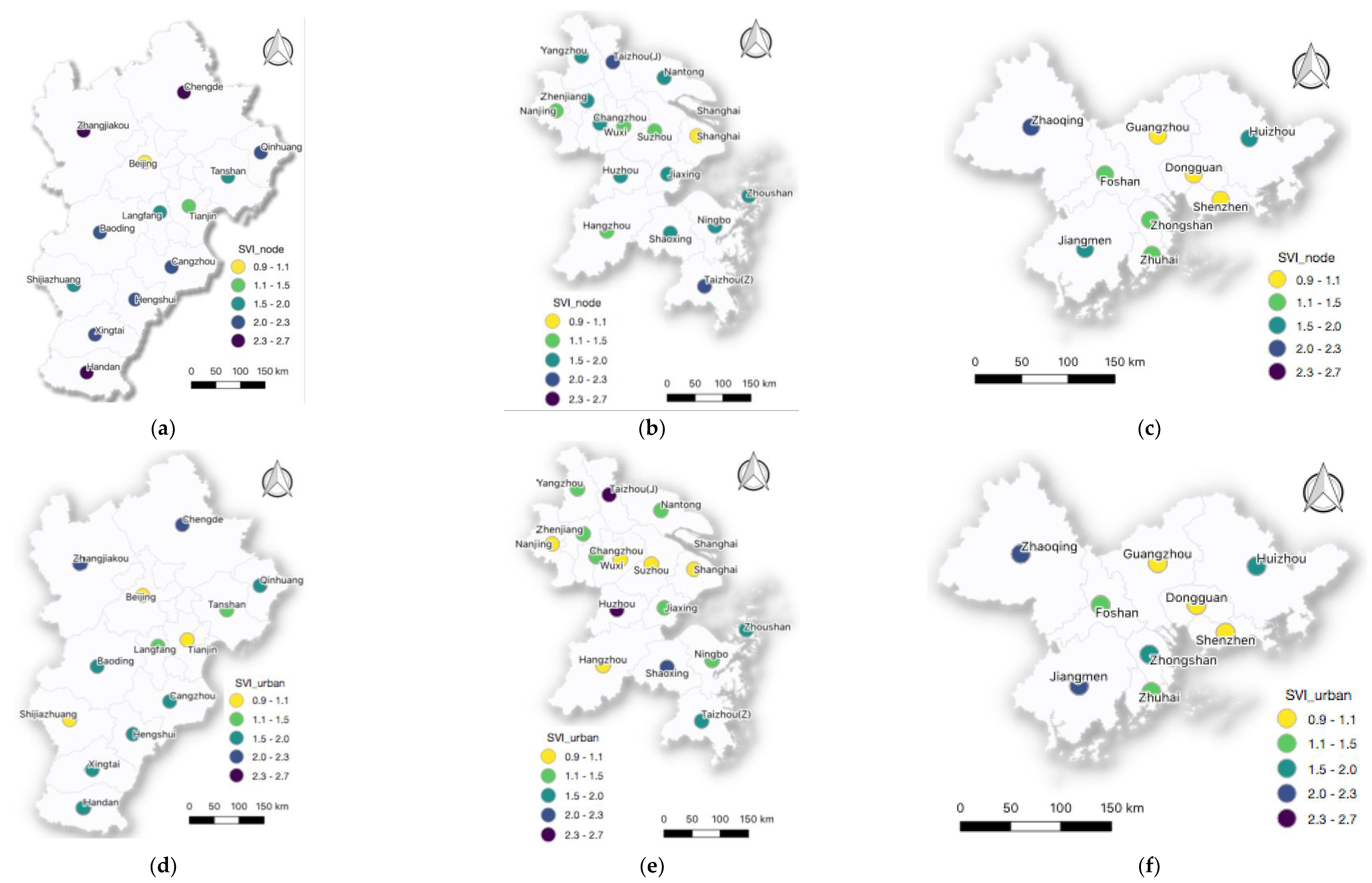Examining Social Vulnerability and Inequality: A Joint Analysis through a Connectivity Lens in the Urban Agglomerations of China
Abstract
:1. Introduction
2. Literature Review: Social Vulnerability and Inequality
3. Materials and Methods
3.1. Profile of Study Area
3.2. Methods
3.2.1. SVI of Individual Cities
3.2.2. SVI of Cities in Urban Networks
3.2.3. Inequality Analysis
4. Results
4.1. SVI Indicators and Their Inequaities
4.2. Connectivity Structure and Inequalities
4.3. SVI and Inequalities
5. Discussion and Conclusions
Author Contributions
Funding
Acknowledgments
Conflicts of Interest
References
- Sall, C. Climate trends and impacts in china. Discuss. Pap. 2013, 48. [Google Scholar]
- Pelling, M. The Vulnerability of Cities: Natural Disasters and Social Resilience; Earthscan: London, UK; Sterling, VA, USA, 2003. [Google Scholar]
- Nguyen, C.V.; Horne, R.; Fien, J. Assessment of social vulnerability to climate change at the local scale: development and application of a Social Vulnerability Index. Clim. Chang. 2017, 143, 355–370. [Google Scholar] [CrossRef]
- Gnansounou, E. Assessing the energy vulnerability: Case of industrialised countries. Energy Policy 2008, 36, 3734–3744. [Google Scholar] [CrossRef]
- McCarthy, J.J.; Canziani, O.F.; Leary, N.A.; Dokken, D.J.; White, K.S. Climate Change 2001: Impacts, Adaptation and Vulnerability; McCarthy, J.J., Canziani, O.F., Leary, N.A., Dokken, D.J., White, K.S., Eds.; Cambridge University Press: Cambridge, UK, 2001. [Google Scholar]
- Panthi, J.; Aryal, S.; Dahal, P.; Bhandari, P. Livelihood vulnerability approach to assessing climate change impacts on mixed agro-livestock smallholders around the Gandaki River Basin in Nepal. Reg. Environ. Chang. 2016, 16, 1121–1132. [Google Scholar] [CrossRef]
- Hamdan, R.; Kari, F.; Othman, A. Biophysical vulnerability impact assessment of climate change on aquaculture sector development in Sarawak, Malaysia. Dlsu Bus. Econ. Rev. 2015, 24, 32–44. [Google Scholar]
- Mavhura, E.; Manyena, B.; Collins, A.E. An approach for measuring social vulnerability in context: The case of flood hazards in Muzarabani district, Zimbabwe. Geoforum 2017, 86, 103–117. [Google Scholar] [CrossRef]
- Füssel, H.M. How inequitable is the global distribution of responsibility, capability, and vulnerability to climate change: A comprehensive indicator-based assessment. Glob. Environ. Chang. 2010, 20, 597–611. [Google Scholar] [CrossRef]
- Ciurean, R.L.; Schröter, D.; Glade, T. Conceptual Frameworks of Vulnerability Assessments for Natural Disasters Reduction. In Approaches to Disaster Management-Examining the Implications of Hazards, Emergencies and Disasters; Tiefenbacher, J., Ed.; INTECH Open Access Publisher: London, UK, 2013. [Google Scholar] [Green Version]
- Huynh, L.T.M.; Stringer, L.C. Multi-scale assessment of social vulnerability to climate change: An empirical study in coastal Vietnam. Clim. Risk Manag. 2018, 20, 165–180. [Google Scholar] [CrossRef]
- Villágran de León, J.C. Vulnerability-a Conceptual and Methodological Review; United Nations University Institute for Environment and Human Security: Bonn, Germany, 2006. [Google Scholar]
- Wisner, B.; Blaikie, P.; Cannon, T.; Davis, I. At Risk: Natural Hazards, People’s Vulnerability, and Disasters, 2nd ed.; Routledge: London, UK, 2004. [Google Scholar]
- Cutter, S.L.; Boruff, B.J.; Lynn Shirley, W. Social Vulnerability to Environmental Hazards. Soc. Sci. Q. 2003, 84, 242–261. [Google Scholar] [CrossRef]
- Birkmann, J. Measuring vulnerability to promote disaster-resilient societies: Conceptual frameworks and definitions. In Measuring Vulnerability; United Nations University Press: Tokyo, Japan; New York, NY, USA; Paris, France, 2006; pp. 9–54. [Google Scholar]
- Frigerio, I.; Carnelli, F.; Cabinio, M.; De Amicis, M. Spatiotemporal Pattern of Social Vulnerability in Italy. Int. J. Disaster Risk Sci. 2018, 9, 249–262. [Google Scholar] [CrossRef] [Green Version]
- Wood, N.J.; Burton, C.G.; Cutter, S.L. Community variations in social vulnerability to Cascadia-related tsunamis in the U.S. Pacific Northwest. Nat. Hazards 2010, 52, 369–389. [Google Scholar] [CrossRef]
- Gatto, A.; Busato, F. Defining, Measuring and Ranking Energy Vulnerability Andrea Gatto and Francesco Busato; CREATES Research Paper 2019-1; Department of Economics and Business Economics, Aarhus University: Aarhus, Denmark, 2019. [Google Scholar]
- Holand, I.S.; Lujala, P. Replicating and Adapting an Index of Social Vulnerability to a New Context: A Comparison Study for Norway. Prof. Geogr. 2012, 65, 120529141302005. [Google Scholar] [CrossRef]
- Guillard-gonçalves, C.; Cutter, S.L.; Emrich, C.T. Application of Social Vulnerability Index (SoVI) and delineation of natural risk zones in Greater Lisbon, Portugal. J. Risk Res. 2015, 9877, 1–24. [Google Scholar] [CrossRef]
- Hou, J.; Lv, J.; Chen, X.; Yu, S. China’s regional social vulnerability to geological disasters: evaluation and spatial characteristics analysis. Nat. Hazards 2016, 84, 97–111. [Google Scholar] [CrossRef]
- Agovino, M.; Cerciello, M.; Gatto, A. Policy efficiency in the field of food sustainability. The adjusted food agriculture and nutrition index. J. Environ. Manag. 2018, 218, 220–233. [Google Scholar] [CrossRef] [PubMed]
- Noradika, Y.; Sungsu, M. Assessment of social vulnerability to natural hazards in South Korea: Case study for typhoon hazard. Spat. Inf. Res. 2017, 25, 99–116. [Google Scholar]
- Yenneti, K.; Tripathi, S.; Wei, Y.D.; Chen, W.; Joshi, G. The truly disadvantaged? Assessing social vulnerability to climate change in urban India. Habitat Int. 2016, 56, 124–135. [Google Scholar] [CrossRef]
- Douglas, I.; Alam, K.; Maghenda, M.; Mcdonnell, Y.; Mclean, L.; Campbell, J. Unjust waters: Climate change, flooding and the urban poor in Africa. Environ. Urban. 2008, 20, 187–205. [Google Scholar] [CrossRef]
- Ramin, B.; Svoboda, T. Health of the homeless and climate change. J. Urban Heal. 2009, 86, 654–664. [Google Scholar] [CrossRef]
- Blackburn, R.M.; Blackburn, R.M. What is social inequality? Int. J. Sociol. Soc. Policy 2008, 28, 250–259. [Google Scholar] [CrossRef]
- Frankenberg, E.; Sikoki, B.; Sumantri, C.; Suriastini, W.; Thomas, D. Education, vulnerability, and resilience after a natural disaster. Ecol. Soc. 2013, 18, 16. [Google Scholar] [CrossRef] [PubMed]
- van der Land, V.; Hummel, D. Vulnerability and the role of education in environmentally induced migration in Mali and Senegal. Ecol. Soc. 2013, 18, 14. [Google Scholar] [CrossRef]
- Deressa, T.T.; Hassan, R.M.; Ringler, C.; Alemu, T.; Yesuf, M. Determinants of farmers’ choice of adaptation methods to climate change in the Nile Basin of Ethiopia. Glob. Environ. Chang. 2009, 19, 248–255. [Google Scholar] [CrossRef] [Green Version]
- Durant, T.J. The utility of vulnerability and social capital theories in studying the impact of Hurricane Katrina on the elderly. J. Fam. Issues 2011, 32, 1285–1302. [Google Scholar] [CrossRef]
- Andrew, M.K.; Mitnitski, A.B.; Rockwood, K. Social vulnerability, frailty and mortality in elderly people. Plos One 2008, 3, 1–8. [Google Scholar] [CrossRef] [PubMed]
- Peek, L. Children and Disasters: Understanding Vulnerability, Developing Capacities, and Promoting Resilience—An Introduction. Child. Youth Environ. 2008, 18, 1–29. [Google Scholar]
- Cutter, S.L. Vulnerability to environmental hazards. Prog. Hum. Geogr. 1996, 20, 529–539. [Google Scholar] [CrossRef]
- Maguire, B.; Hagan, P. Disasters and communities: Understanding social resilience. Aust. J. Emerg. Manag. 2007, 22, 16–20. [Google Scholar]
- Warikoo, N.; Carter, P. Cultural Explanations for Racial and Ethnic Stratification in Academic Achievement: A Call for a New and Improved Theory. Rev. Educ. Res. 2009, 79, 366–394. [Google Scholar] [CrossRef] [Green Version]
- Lareau, A. Unequal Childhoods: Class, Race, and Family Life; University of California Press: Berkeley, CA, USA, 2003. [Google Scholar]
- Elder, K.; Xirasagar, S.; Miller, N.; Bowen, S.; Glover, S.; Piper, C. African-American’s decisions not to evacuate New Orleans before Hurricane Katrina: A qualitative study. Am. J. Pub. Heal. 2007, 97, S124–S129. [Google Scholar] [CrossRef]
- Siegal, J. Emotional injury and the Northridge, California earthquake. Nat. Hazards Rev. 2000, 1, 204–211. [Google Scholar] [CrossRef]
- Bethel, J.W.; Burke, S.C.; Britt, A.F. Disparity in disaster preparedness between racial/ethnic groups. Disaster Heal. 2013, 1, 110–116. [Google Scholar] [CrossRef] [PubMed] [Green Version]
- Fothergill, A.; Maestas, E.G.M.; Darlington, J.D. Race, Ethnicity and Disasters in the United States: A Review of the Literature. Disasters 1999, 23, 156–173. [Google Scholar] [CrossRef]
- Ge, Y.; Dou, W.; Zhang, H. A new framework for understanding urban social vulnerability from a network perspective. Sustainability 2017, 9, 1723. [Google Scholar] [CrossRef]
- Tan, Y.; Liu, X.; Hugo, G. Exploring relationship between social inequality and adaptations to climate change: evidence from urban household surveys in the Yangtze River delta, China. Popul. Environ. 2015, 36, 400–428. [Google Scholar] [CrossRef]
- Bie, J.; De Jong, M.; Tang, J. The greater pearl river delta (PRD) as a global city region its shape and development. In Proceedings of the Next Generation Infrastructure Systems for Eco-Cities, Shenzhen, China, 11–13 November 2010; pp. 1–5. [Google Scholar]
- Gu, C.; Hu, L.; Zhang, X.; Wang, X.; Guo, J. Climate change and urbanization in the Yangtze River Delta. Habitat Int. 2011, 1–9. [Google Scholar] [CrossRef]
- Zhang, K. The impacts of global climate change on extreme weather events in Beijing-Tianjin-Hebei area and the countermeasures for disaster prevention. J. Arid L. Resour. Environ. 2011, 25, 122–125. [Google Scholar]
- Gong, D.; Han, H. Extreme Climate Events in Northern China over the Last 50 Years. Acta Geogr. Sin. 2004, 59, 230–238. [Google Scholar]
- Huang, Z.; Zong, Y.; Zhang, W. Coastal inundation due to sea level rise in the PRD, China. Nat. Hazards 2004, 33, 247–264. [Google Scholar] [CrossRef]
- Tracy, A.; Trumbull, K.; Loh, C. Impact of Climate Change in Hong Kong and the Pearl River Delta. China Perspect. 2007, 1, 18–29. [Google Scholar] [CrossRef]
- Maggino, F.; Zumbo, B.D. Measuring the Quality of Life and the Construction of Social Indicators. In Handbook of Social Indicators and Quality of Life Research; Land, K.C., Ed.; Springer Science+Business Media B.V.: Heidelberg, Germany, 2012; pp. 201–238. [Google Scholar]
- Jones, M.C.; Sibson, R. What is Projection Pursuit? J. R. Stat. Soc. Ser. A 1987, 150, 1–37. [Google Scholar] [CrossRef]
- Nason, G.P. Robust projection indices. J. R. Stat. Soc. Ser. B Stat. Methodol. 2001, 63, 551–567. [Google Scholar] [CrossRef] [Green Version]
- Boulton, A.; Devriendt, L.; Brunn, S.; Derudder, B.; Witlox, F. City networks in cyberspace and time: Using Google hyperlinks to measure global economic and environmental crises. In ICTs for Mobile and Ubiquitous Urban Infrastructures: Surveillance, Locative Media and Global Networks; Firmino, R.J., Duarte, F., Ultramari, C., Eds.; IGI Global: Hershey, PA, USA, 2011; pp. 67–87. [Google Scholar]
- Baidu the Baidu Index. Available online: https://zhishu.baidu.com/ (accessed on 2 June 2018).
- Theil, H. Economics and Information Theory; North-Holland Publishing Company: Amsterdam, The Nertherlans, 1967. [Google Scholar]
- Malakar, K.; Mishra, T.; Patwardhan, A. Inequality in water supply in India: An assessment using the Gini and Theil indices. Environ. Dev. Sustain. 2018, 20, 841–864. [Google Scholar] [CrossRef]
- Alcantara, V.; Duro, J.A. Inequality of energy intensities across OECD countries: A note. Energy Policy 2004, 32, 1257–1260. [Google Scholar] [CrossRef]
- Zhang, L.; Yang, Z.; Liang, J.; Cai, Y. Spatial variation and distribution of urban energy consumptions from cities in China. Energies 2010, 4, 26–38. [Google Scholar] [CrossRef]
- Sixth National Population Census Office of State Countil Major Figures on Population Census of China; China Statistics Press: Beijing, China, 2010.








| No. | Dimension of Inequality | Dimension of SVI | Indicator | Description | Impact on SVI |
|---|---|---|---|---|---|
| 1 | Health inequality | Sensitivity | Children | Percentage population under 14 years old | + |
| 2 | Sensitivity | Elderly | Percentage population over 65 years old | + | |
| 3 | Sensitivity | Females | Percentage of female resident population | + | |
| 4 | Cultural inequality | Sensitivity | Ethnic minorities | Percentage of minority population | + |
| 5 | Sensitivity | Illiterate | Percentage illiteracy rate | + | |
| 6 | Economic inequality | Sensitivity | Unemployed | Percentage unemployment population | + |
| 7 | Sensitivity | Poor | Percentage of residents covered by subsistence allowances from the government | + | |
| 8 | Exposure | House with no tap water | Percentage of households without tap water in their houses | + | |
| 9 | Exposure | House with no kitchen | Percentage of households without a kitchen in their houses | + | |
| 10 | Exposure | House with no lavatory | Percentage of households without a lavatory in their houses | + | |
| 11 | Adaptability | GDP | Gross domestic product | − | |
| 12 | Social inequality | Sensitivity | Renters | Percentage of households that live in rented houses | + |
| 13 | Adaptability | Higher education graduated | Percentage of population with a college degree | − | |
| 14 | Adaptability | Green | The greening rate in cities | − | |
| 15 | Adaptability | Hospitals | Number of Hospitals | − | |
| 16 | Adaptability | Employees in management sector | Percentage employed in management sector | − |
| No. | Indicator | Weight | % |
|---|---|---|---|
| 1 | GDP | 0.42 | 11.84% |
| 2 | Higher education graduated | 0.34 | 9.71% |
| 3 | Children | 0.33 | 9.22% |
| 4 | Illiterate | 0.31 | 8.70% |
| 5 | Employees in management sector | 0.3 | 8.43% |
| 6 | Elderly | 0.28 | 7.87% |
| 7 | Poor | 0.26 | 7.37% |
| 8 | Houses with no lavatory | 0.26 | 7.39% |
| 9 | Green | 0.26 | 7.24% |
| 10 | Females | 0.22 | 6.31% |
| 11 | Houses with no tap water | 0.22 | 6.21% |
| 12 | Ethnic minorities | 0.14 | 3.90% |
| 13 | Houses with no kitchen | 0.1 | 2.72% |
| 14 | Unemployed | 0.05 | 1.32% |
| 15 | Hospital | 0.04 | 1.17% |
| 16 | Renters | 0.02 | 0.60% |
| Level 1 | Level 2 | Level 3 | Level 4 | Level 5 | ||
|---|---|---|---|---|---|---|
| JJJ | SVInode | 1 | 1 | 3 | 4 | 4 |
| SVIurban | 2 | 2 | 7 | 2 | 0 | |
| YRD | SVInode | 1 | 4 | 9 | 2 | 0 |
| SVIurban | 5 | 6 | 2 | 1 | 2 | |
| PRD | SVInode | 3 | 3 | 2 | 1 | 0 |
| SVIurban | 3 | 2 | 2 | 2 | 0 |
© 2019 by the authors. Licensee MDPI, Basel, Switzerland. This article is an open access article distributed under the terms and conditions of the Creative Commons Attribution (CC BY) license (http://creativecommons.org/licenses/by/4.0/).
Share and Cite
Ge, Y.; Yang, G.; Chen, Y.; Dou, W. Examining Social Vulnerability and Inequality: A Joint Analysis through a Connectivity Lens in the Urban Agglomerations of China. Sustainability 2019, 11, 1042. https://doi.org/10.3390/su11041042
Ge Y, Yang G, Chen Y, Dou W. Examining Social Vulnerability and Inequality: A Joint Analysis through a Connectivity Lens in the Urban Agglomerations of China. Sustainability. 2019; 11(4):1042. https://doi.org/10.3390/su11041042
Chicago/Turabian StyleGe, Yi, Guangfei Yang, Yi Chen, and Wen Dou. 2019. "Examining Social Vulnerability and Inequality: A Joint Analysis through a Connectivity Lens in the Urban Agglomerations of China" Sustainability 11, no. 4: 1042. https://doi.org/10.3390/su11041042




